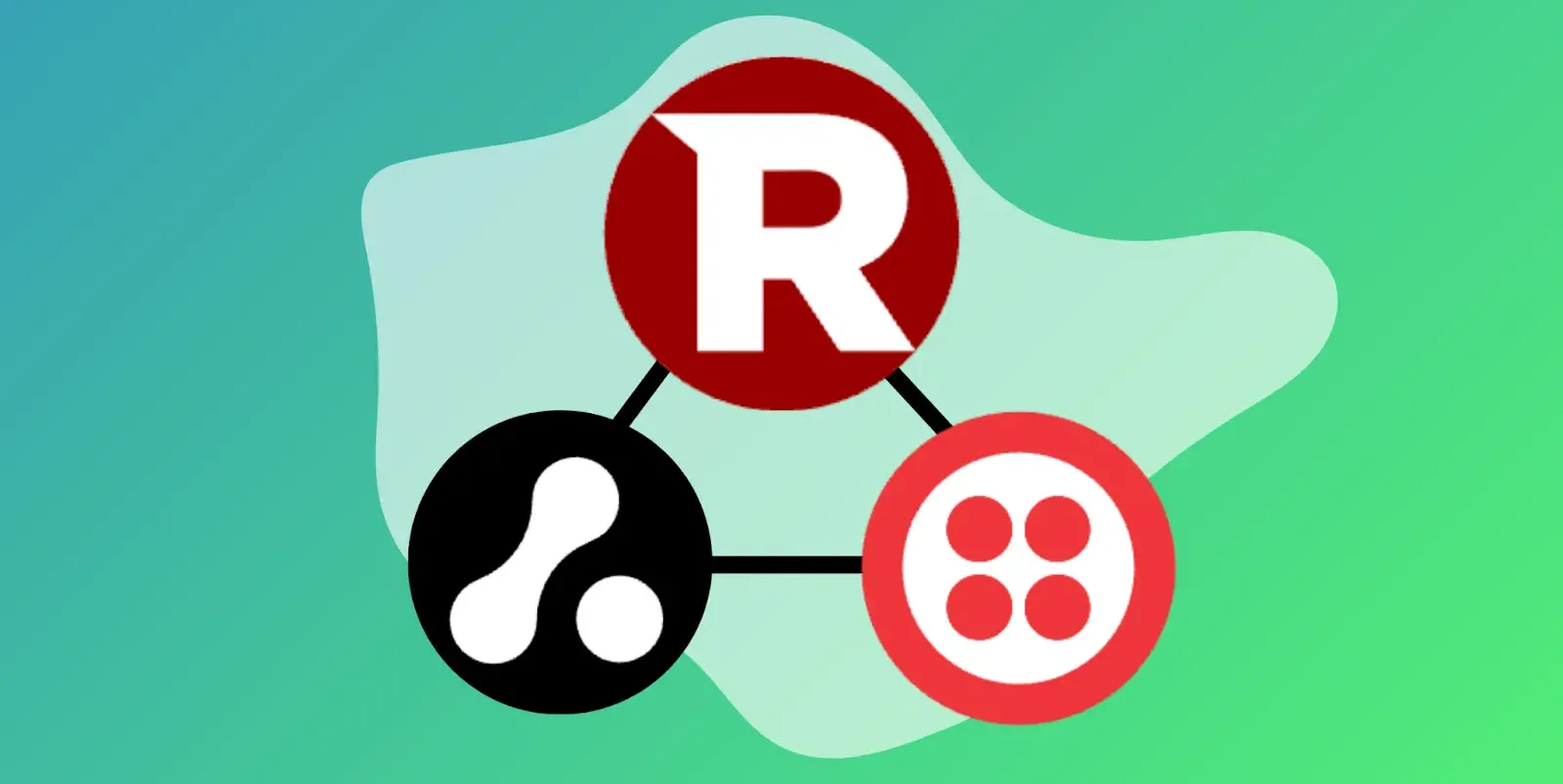In the fast-evolving world of digital marketing, the pressure to connect every dollar spent to a tangible return has never been greater. Yet, despite billions spent on advertising platforms and analytics tools, many organizations still struggle to answer one deceptively simple question:
What’s actually driving our growth?
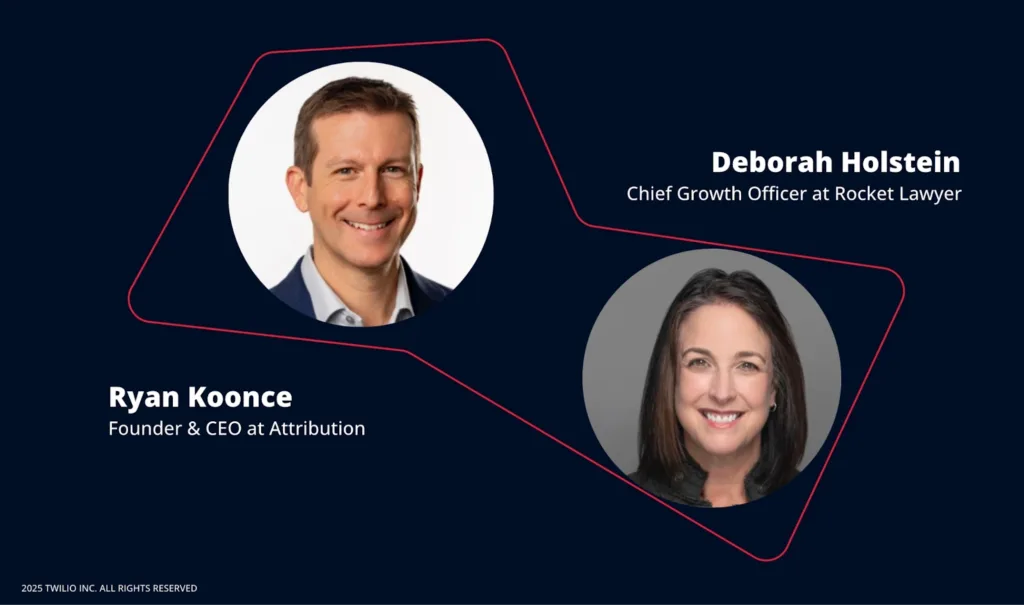
At Twilio SIGNAL 2025, a conversation between Ryan Koonce, CEO of The Attribution Platform, and Deborah Holstein, Chief Growth Officer at Rocket Lawyer, peeled back the layers on this question. Together, they explored the intersection of customer data infrastructure and multi-touch attribution—exposing long-standing myths and revealing actionable truths about how modern companies can finally get attribution right.
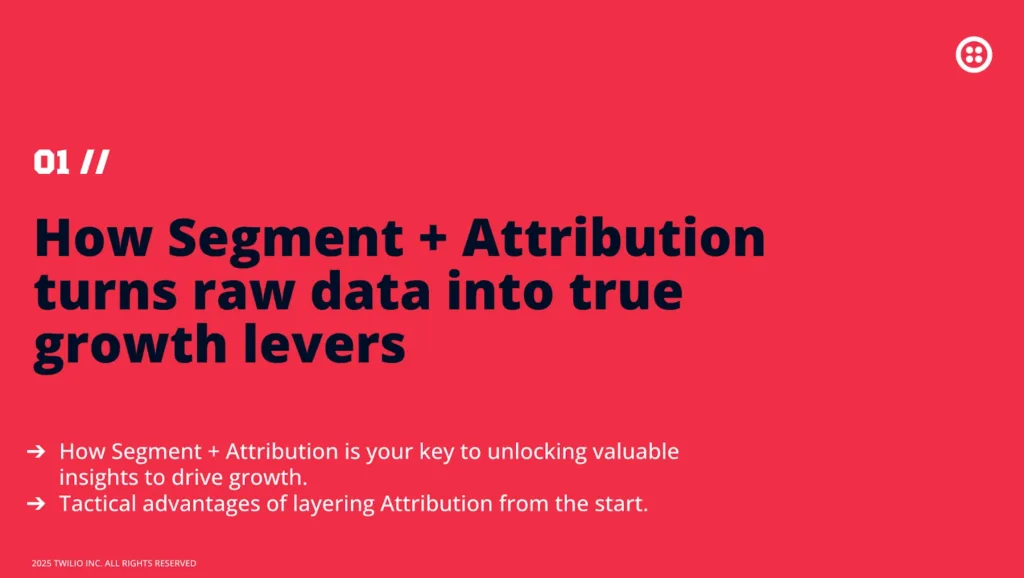
The Attribution Dilemma
Let’s start with the basics: Why is attribution so hard?
Attribution, at its core, is about understanding which marketing efforts actually drive acquisition, engagement, and revenue. But that clarity gets clouded fast when you layer in today’s messy, multi-channel buyer journeys — filled with ad clicks, organic visits, product usage, email touchpoints, and peer referrals spread across devices and platforms.
“Attribution has to work for your business… E-commerce is different than SaaS, is different than enterprise.”
— Deborah Holstein, Chief Growth Officer, Rocket Lawyer
Whether you’re operating a PLG funnel, a sales-led SaaS cycle, or a subscription e-commerce model, each motion demands its own measurement strategy. A one-size-fits-all model won’t cut it — especially when you need to justify spend, inform headcount, or shape your roadmap.
“We could get a horror story over a beer from everyone in here about last-click attribution.”
— Deborah Holstein
The panel kicked off with this universal truth: Last-click is not reality. It oversimplifies complexity, ignores brand and content influence, and leads to bad decisions. If attribution doesn’t reflect the actual journey, it won’t drive meaningful action.
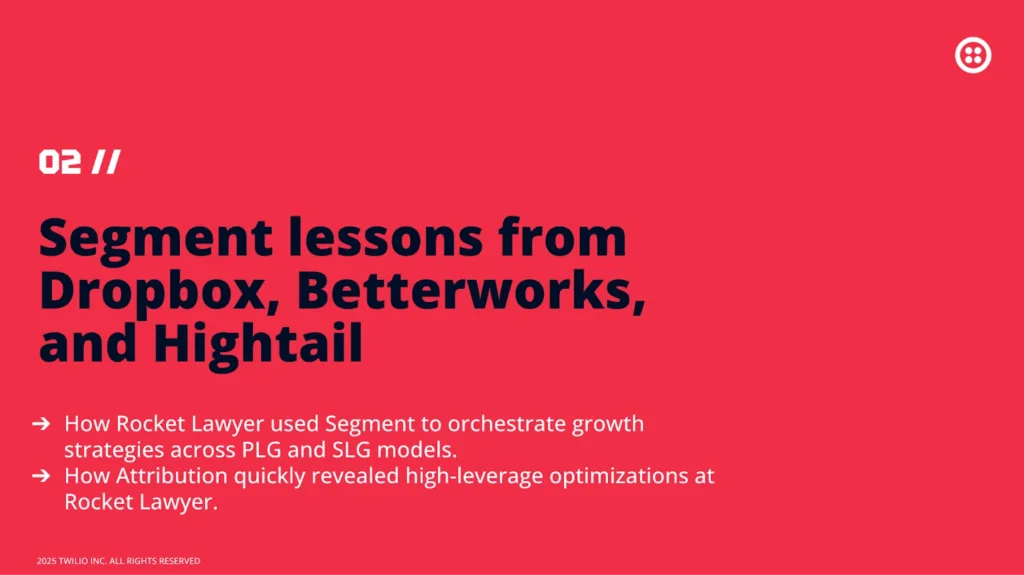
Enter: The Twilio Segment CDP + Attribution Stack
According to Ryan, effective multi-touch attribution rests on three essential pillars:
- User-level cost visibility
- Data auditability
- Model customization
Without these, most attribution systems fall short — either reporting inaccurate results, offering no path to verification, or forcing businesses into rigid, misaligned models.
“Can I aggregate cost on the user? Can I audit the data? And can I customize the model? Those are the three tenets of real attribution.”
— Ryan Koonce, CEO, The Attribution Platform
This is where the Twilio Segment + The Attribution Platform stack shines. Segment acts as the CDP layer, centralizing user data across every touchpoint — from web sessions and product usage to CRM and event streams. On top of that foundation, The Attribution Platform binds in cost data, maps user journeys, and analyzes performance down to the individual campaign, creative, and conversion event.
For Deborah Holstein, implementing Segment was a critical move in enabling trustworthy measurement at Rocket Lawyer:
“One of the things when I joined Rocket Lawyer… was really to make sure that you have that data that is complete and accurate.”
— Deborah Holstein, Chief Growth Officer, Rocket Lawyer
“I really believe that having a CDP is one of the most important things you can do for marketing and for growth. And so I’ve made sure that that has been part of my stack pretty much everywhere I’ve worked.”
— Deborah Holstein
Together, Segment and Attribution give teams not just visibility, but control. Instead of relying on black-box reports or inconsistent tracking, companies can run attribution on clean, unified, first-party data — the way it should be.
The Rocket Lawyer Use Case: From Zero to Insights in 24 Hours
In an era when attribution projects often stretch over quarters—or quietly fail in the background—Rocket Lawyer’s story stands out. Within 24 hours of signing up with The Attribution Platform, the team was already reviewing insights.
“We signed the thing, and then I got the Slack later that day that was like, ‘Okay, we’re all set.’”
— Deborah Holstein, Chief Growth Officer, Rocket Lawyer
Why so fast? The Attribution Platform is built to work as a destination within Segment, meaning it instantly ingests clean, structured event data — no engineering lift required. By combining that with native integrations to ad platforms like Google, Facebook, and LinkedIn, The Attribution Platform can map spend to conversion paths without relying on brittle UTM strings or manual tagging.
And because it’s grounded in Segment’s unified customer profiles, the platform is immediately ready to track user-level journeys, attach cost data, and surface meaningful performance insights — all without the delays typical of warehouse-built attribution stacks.
The impact? For most customers, it’s immediate and tangible:
“Companies that start doing real multi-touch attribution usually save 30% of their ad spend in the first month.”
— Ryan Koonce, Founder & CEO, Attribution
By revealing underperforming campaigns and surfacing hidden high-performers, the stack doesn’t just inform — it drives smarter decisions, fast.
Multi-Touch Attribution Done Right
Ryan and Deborah emphasized that true multi-touch attribution requires moving beyond black-box models.
Most tools, including the ubiquitous Google Analytics, rely on flawed assumptions and limited visibility. Ryan didn’t mince words: “Google Analytics is always wrong.”
Why? Because platforms like GA don’t have access to all the touchpoints. Facebook only sees Facebook clicks. Google only sees Google clicks. But your business needs to see everything—and that’s only possible by tying together cost, conversion, and behavior data at the user level.
With The Attribution Platform, this comprehensive view becomes possible. Marketers can:
- Audit every user touchpoint
- Link touches to costs
- Track conversions and LTV over any timeframe (no more arbitrary 30-day lookbacks)
- Customize models to reflect real customer journeys (e.g., handle free trials or multiple decision-makers)
Ryan Koonce and Deborah Holstein drove home a simple but often ignored truth: multi-touch attribution only works if it’s complete, auditable, and adaptable.
Most tools fail that test.
“Many of you probably have Google Analytics. It might be a surprise to you that Google Analytics is always wrong.”
— Ryan Koonce, Founder & CEO, Attribution
Why the strong stance? Because platforms like GA rely on partial data. Google sees Google. Facebook sees Facebook. Neither sees the whole journey — especially when that journey spans channels, devices, and decision-makers.
By contrast, The Attribution Platform connects the dots:
- Cost data from ad platforms
- Event data from Segment
- Conversion and revenue data from CRMs and product analytics tools
And it ties it all together at the user level, creating a clear, trustworthy picture of what’s really driving outcomes.
“You want your attribution based on actual customer records, not somebody else’s algorithm… because you don’t have any way to know if it’s accurate or not.”
— Deborah Holstein, Chief Growth Officer, Rocket Lawyer
What You Can Do with the Right Stack:
- Audit every user touchpoint
- Link ad spend to real people and real revenue
- Track conversions and LTV over any timeframe — no more arbitrary 30-day windows
- Customize models to reflect your actual funnel: free trials, multi-threaded sales, or product-led motions
With this setup, you’re not guessing. You’re measuring what matters — and shaping strategy based on reality, not assumptions.
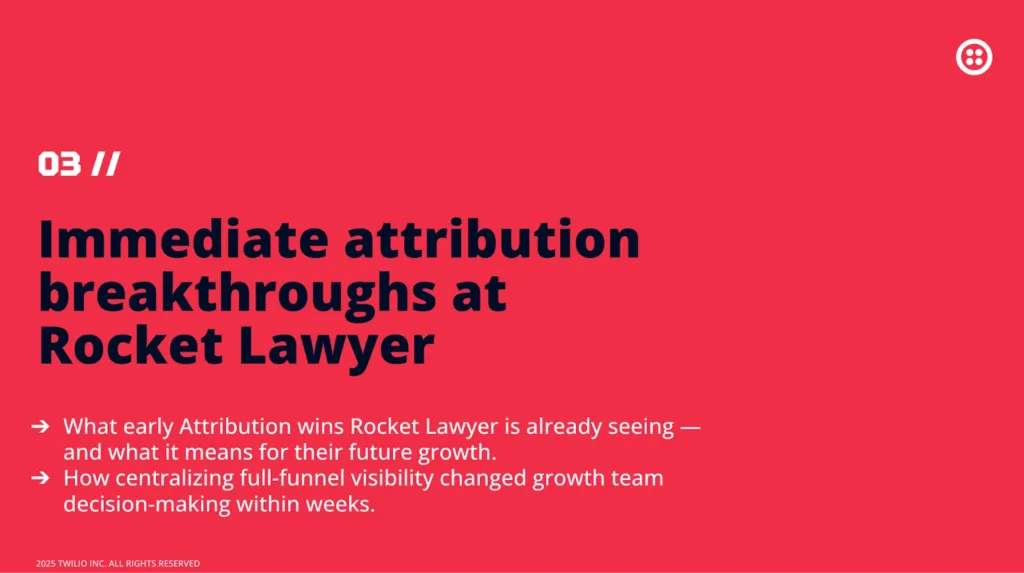
Real-Time Flexibility for Complex Journeys
Modern B2B funnels are rarely linear. One person discovers the product. Another makes the purchase. In many attribution systems, these disconnected actions become separate records — a missed opportunity to understand the real story.
That’s where the The Attribution Platform + Segment integration changes the game.
“Imagine someone comes in and uses the product, starts a free trial, but they don’t pay… Then they invite the CFO, who does pay. In traditional systems, that’s two separate customer journeys.”
— Ryan Koonce, Founder & CEO, Attribution
With Segment’s unified profiles and The Attribution Platform’s model logic, you can bind users together at the company level, even when different people engage at different times. The platform uses:
- Email domains
- Explicit invites
- CRM records from Salesforce or HubSpot
This lets your attribution model reflect how buying actually happens in team-based environments — especially for PLG-to-enterprise motions.
“We provide the multi-touch view on how the user got to the purchase event — but also bind users into a company attribution model.”
— Ryan Koonce
That Means Marketing Can Finally Answer:
- Who really brought this customer in?
- Which campaign sparked the original interest?
- How should we allocate credit across the full journey — not just the last click?
In other words, attribution that actually matches how modern teams buy — and how high-performing GTM teams operate.
Empowering the Whole Business, Not Just Marketing
One of the most compelling takeaways from Ryan and Deborah’s session was this: Attribution—when done right—isn’t a marketing function. It’s a business function.
By integrating directly with modern data stacks — including Snowflake, Redshift, BigQuery, and Databricks — The Attribution Platform turns customer-level data into a shared decision-making engine for the entire company.
“There’s a lot of value that marketing users can get from The Attribution Platform… but it’s also super important for the finance team and analytics folks, because it ties the work of growth to the forecasting and modeling for the business.”
— Deborah Holstein, Chief Growth Officer, Rocket Lawyer
This shared visibility unlocks impact across teams:
- Finance can confidently link CAC and LTV to actual revenue signals
- Data science can build MMM models on top of clean, deterministic input
- Product can optimize flows based on true customer value, not just usage
- Executives can reallocate budget based on evidence—not intuition
It’s attribution not just as a report—but as a strategic infrastructure layer that connects investment with outcome across every GTM function.
“Attribution isn’t just something marketing does. It’s a business-wide decision-making tool.”
— Deborah Holstein
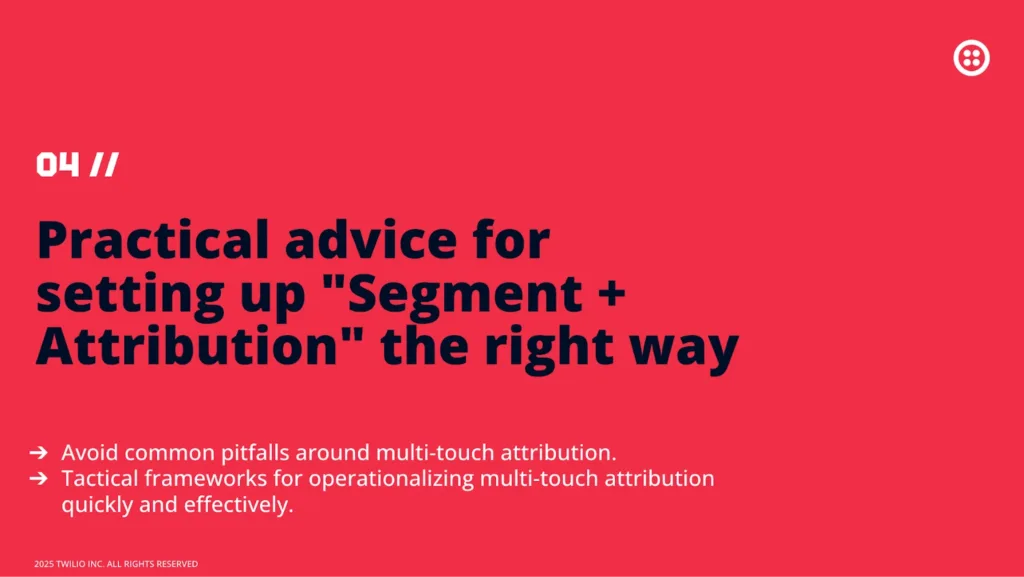
Pitfalls to Avoid
Getting attribution right is transformative. But most companies never get there — not because the concept is flawed, but because they fall into a few avoidable traps.
Ryan Koonce summed it up bluntly:
“Most companies think they can build this in their warehouse. Ninety percent fail.”
— Ryan Koonce, Founder & CEO, Attribution
Here are the most common reasons why:
- Incomplete or low-fidelity data: Without a CDP like Segment to unify customer events across tools, your attribution model is built on fragmented insight.
- Over-reliance on UTM strings: Manual tagging is error-prone, inconsistent, and impossible to scale — especially across teams or vendors.
- Rigid, uncustomizable models: If your attribution tool can’t support your specific funnel — like a free trial start, SQL milestone, or multi-threaded B2B handoff — it won’t reflect how your business actually grows.
- Disconnected data silos: Warehouses often seem like the answer — until engineering resourcing, pipeline fragility, and analytics sprawl grind attribution projects to a halt.
“One of the things we see is companies try to piece it together with Fivetran, APIs, and spreadsheets — and it almost always fails.”
— Ryan Koonce
The takeaway? Attribution success isn’t about building a Rube Goldberg machine in your data stack. It’s about plugging into the right foundation — and giving your teams the flexibility to measure what actually matters.
What About TV, OTT, or Out-of-Home?
An audience member raised a familiar challenge: How do you measure attribution for channels that aren’t clickable—like linear TV, OTT, or out-of-home (OOH)?
Ryan Koonce responded with a principle every growth leader should keep in mind:
“Measure what you can measure.”
— Ryan Koonce, Founder & CEO, Attribution
Offline channels may not generate UTM links, but that doesn’t mean they’re immeasurable. The key is to use smart proxies and structured experiments:
- Spot logs from TV or radio buys
- Geofenced time windows for regional campaigns
- Branded search lift or direct traffic spikes post-campaign
- Self-reported attribution via demo forms or surveys
The Attribution Platform supports these tactics by allowing marketers to input non-click-based events and assign credit according to their business context.
“You can still measure things like branded lift and correlated behavior… It’s not perfect, but it’s directional, and you can feed it into the model.”
— Ryan Koonce
In other words, perfection isn’t the goal — decision support is. And with the right tools, even untrackable channels can earn the credit they deserve.
Attribution for Mobile vs. Web
A common audience question focused on mobile attribution — and how tools like AppsFlyer or Branch compare or integrate with The Attribution Platform.
Ryan Koonce clarified the distinction:
“We don’t try to do mobile attribution. That’s what AppsFlyer and Branch are for.”
— Ryan Koonce, Founder & CEO, Attribution
The Attribution Platform is purpose-built for web attribution — mapping user journeys, tying in ad spend, and analyzing multi-touch performance across browser-based environments.
That said, teams can still bring mobile data into the broader attribution picture. By piping AppsFlyer or Branch data into Segment, you can include mobile attribution signals in The Attribution Platform’s reporting.
The main constraint isn’t the technology — it’s data policy.
“Facebook’s terms of service for mobile and web are different, so we respect that. It’s not that it can’t be done technically — it’s that we have to play by the rules.”
— Ryan Koonce
Bottom Line:
- The Attribution Platform tracks web journeys with precision
- Mobile signals can be ingested through Segment
- Platform terms dictate how attribution data can be handled across environments
If it lives on your website, The Attribution Platform owns it. If it starts in the App Store — AppsFlyer and Branch are your best bet.
Attribution in a Post-GA World
As privacy regulations tighten and third-party signals continue to decay, more companies are making a bold move: leaving Google Analytics behind.
And according to Ryan and Deborah, that’s not a bad thing.
“Google Analytics is always wrong… It gives you a very partial view that’s not tied to actual revenue.”
— Ryan Koonce, Founder & CEO, Attribution
GA may have been the default analytics tool for the past decade, but its limitations are now deal-breakers:
- It tracks sessions, not people
- It samples data and applies opaque modeling
- It can’t unify product, ad, and CRM data
- It’s increasingly hobbled by cookie loss and privacy changes
With Segment and The Attribution Platform, companies get a future-proof alternative built for the realities of modern GTM:
- Real user-level data, not sampled session metrics
- End-to-end visibility across marketing, product, and sales
- A foundation for experimentation, cohort analysis, and strategic growth decisions
“With The Attribution Platform and a CDP like Segment, you’re not dependent on anyone else’s model. You’re measuring what’s actually happening in your funnel.”
— Deborah Holstein, Chief Growth Officer, Rocket Lawyer
In short: the era of retrofitting GA for modern attribution is over. It’s time for a stack that reflects how growth actually works — and how users actually buy.
The Future of Attribution is Custom, Cohort-Based, and Auditable
he attribution conversation is evolving. What once passed as “good enough” — last-click reports, channel-level dashboards, vague brand lift — is no longer sufficient.
Today’s growth leaders want more:
- Precision in how marketing spend translates to pipeline and revenue
- Transparency in how models are built and credit is assigned
- Flexibility to adapt attribution to their unique business model, funnel, and team structure
As Ryan Koonce emphasized throughout the session, first-party data is the foundation. The Attribution Platform, powered by Segment, makes it possible to link every dollar spent to the full arc of user behavior — from first touch to long-term value.
“Attribution should help you make better decisions — and you can’t do that with black boxes or hard-coded assumptions.”
— Ryan Koonce, Founder & CEO, Attribution
By layering cohort analysis, custom conversion events, and auditable model logic, teams aren’t just reporting outcomes — they’re steering growth strategy with confidence.
“The future of attribution is actionable, explainable, and aligned across the org.”
— Deborah Holstein, Chief Growth Officer, Rocket Lawyer
The Road Ahead:
- Build on clean, first-party data
- Adopt tools that enable custom models and cross-functional trust
- Move from reporting to strategic decision-making
Attribution, done right, isn’t just a marketing tool. It’s the operating system for modern growth.
Final Thoughts: You Can’t Improve What You Can’t See
At the end of the day, attribution isn’t about vanity metrics or proving marketing’s worth. It’s about making better investment decisions.
“It’s not just for marketers… It’s for every stakeholder who needs to understand what’s working and what’s not.”
— Deborah Holstein, Chief Growth Officer, Rocket Lawyer
When done right, attribution aligns teams across marketing, product, finance, and the executive suite. It turns assumptions into insight — and chaos into clarity.
When done poorly, it leads to blind bets, misallocated budgets, and internal misalignment.
But the tools and playbooks now exist to get it right. With Segment as your customer data foundation and The Attribution Platform layered on top, you get:
- Plug-and-play infrastructure
- Cross-functional visibility
- Auditable insights tied to actual revenue
“The real win is when attribution becomes part of your GTM operating rhythm — not just a quarterly marketing report.”
— Ryan Koonce, Founder & CEO, Attribution
So the only question that remains: Are you ready to see what’s really driving growth?
The Partnership Driving This Momentum
This work was made possible in part because of the deep collaboration between The Attribution Platform and Twilio Segment. As announced at SIGNAL 2025, The Attribution Platform was named one of only two official Preferred Partners by Twilio Segment—alongside Amplitude—solidifying its position as the premier solution for multi-touch attribution across B2B, SaaS, and e-commerce markets.
This partnership enables teams to activate advanced attribution models in minutes through a direct integration with Segment, with plug-and-play support for platforms like Salesforce, HubSpot, and Shopify. The result: faster time-to-insight, lower engineering lift, and clearer ROI on every dollar spent.
📣 Read the official press release on Benzinga →
The Attribution Platform Named One of Two Preferred Partners by Twilio Segment
